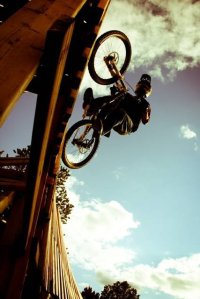So how do you train for the Megavalanche? I asked MTB coach James Wilson, a.k.a. Bike James. ‘Don’t train your muscles, train movement patterns’, he says.
James specializes in strength and cardio programs for mountain bikers. He has been coaching some of the best riders in the world and it’s obvious that he loves his job. I can cross five questions of my list with his first answer.
‘First, let me say this’, James starts. ‘With these races, where you ride thirty-something kilometres, we all think that in order to ride effectively we need to be in real good shape, leading people to focus on cardio training. Of course, this is necessary, but it’s not the most important thing. The skill aspect is. Good skills give you better balance and control, which means you can endure longer using less energy. Cardio training, therefore, should never go at the expense of actual mountain biking.’
‘Another thing that’s really important is flexibility. If you’re not able to touch your toes, you’re not going to be able to move well on your bike.’
‘Cardio becomes important when the race starts closing in and you need to get in shape. And when you do start this, don’t make it a monster Frankenstein kind of cardio, just focus on basic skills and exercises.’
‘That kind of was the long way to answer’, James wraps up. ‘But yeah, I think it can be done.’ For those of you wondering, I told James about my plans and asked him or he thinks it can be done, considering my fitness levels are really poor.
“Ride as hard as you can. Your body isn’t stupid.”
On your blog, you say that one’s training should fit the type of race he or she is going to ride. How would you apply that to the Megavalanche?
‘First of all, you should vary your training between three different rhythms when you go out and ride. Hard, moderate and light. You need a balance of these three.’
‘I’ve heard guys say they do sessions of three hours because it takes them 45 minutes to get warm. That’s because your body isn’t stupid. It thinks, “oh here we go again, a three-hour slogfest”, so it saves energy. It’s better to ride on a trail like you’re doing intervals. Ride as hard as you can for a short period, rest or switch to an easier rhythm and then repeat. This does not mean you should ride like this every time you get on your bike. It’s good to throw light or moderate riding sessions in the mix. I have days where I go out and try to pedal as little as possible and just really focus on my technique.’
“My #1 recommendation: Get used to standing pedaling.”
For a race like the Megavalanche, what’s the most important skill tip you would give?
‘There’s a lot of standing in endurance mountain biking. To hold that position for a long time is hard, so you will really have to practice that. That’s my number one recommendation: get used to standing pedalling. Siting should be used as a rest position, especially on the easier pedalling sections.’
 On your blog, you also name three training elements. Skills, cardio and strength training. I’m guessing the last one can help with standing pedalling. Which exercises would you advise?
On your blog, you also name three training elements. Skills, cardio and strength training. I’m guessing the last one can help with standing pedalling. Which exercises would you advise?
‘With strength training, it’s important that you don’t just train the different muscle groups. Instead, you should focus on movement patterns. There are five basic patterns: hinging, squatting, pushing, pulling and a locomotive pattern. Build your exercising program around these five patterns. To train your legs, for instance, hip hinging and squatting are good exercises. And don’t hesitate to use dumbbells or kettlebells. You need to add some load if you want to get stronger.’
“This type of training becomes even more important if you’re a low altitude rider.”
So how would you best combine these elements to a full training?
‘It depends on the amount of time you have but I would recommend doing strength training at least twice a week next to your riding. If you’re in low altitude you may want to double your strength and interval training. The Megavalanche takes place on great height, which means that your muscles will become anaerobic a lot quicker because your body isn’t used to the lower oxygen levels. It is the ability to deal with these anaerobic conditions that you want to improve. That can be done by getting stronger so your body can recruit more muscle fibres. Then train them to deal with anaerobic conditions using the interval method.’
James’ method is also mentioned in the book Mastering Mountainbike Skills by Brian Lopes and Lee McCormack. If you want to learn more you can also visit James’ blog, on which he gives a lot of training tips.
